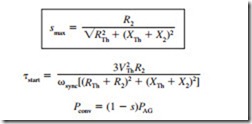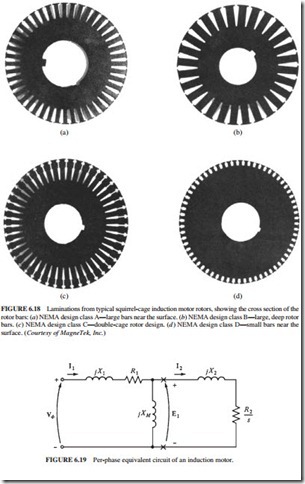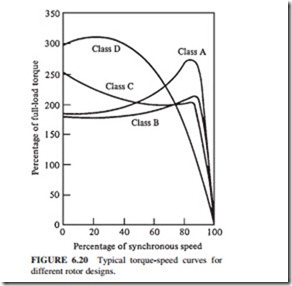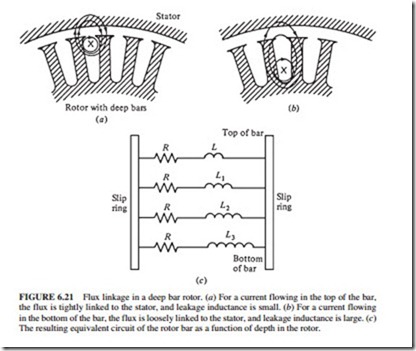CONTROL OF MOTOR CHARACTERISTICS BY SQUIRREL-CAGE ROTOR DESIGN
The reactance X2 in the equivalent circuit of an induction motor represents the rotor’s leakage reactance. This is the reactance due to the rotor flux lines that do not couple with the stator windings. In general, the farther away a rotor bar is from the stator, the greater its leakage reactance because a smaller percentage of the bar’s flux reaches the stator. Therefore, if the bars of a squirrel-cage motor are placed near the surface of the rotor, the leakage reactance X2 will be small. If the bars are placed deeper into the rotor, X2 will be larger.
Figure 6.18a illustrates rotor lamination showing the cross section of the bars in the rotor. The bars are large and placed near the surface of the rotor. This design has a low resis- tance (due to the large cross section of the bars) and a low leakage reactance X2 (due to the bar’s location near the surface).
The slip at pullout torque Smax, the starting torque Tstart, and the converted power to mechanical form are given by
where VTh, RTh, and XTh are the Thevenin equivalent of the portion of the circuit to the left of the X’s in Fig. 6.19. Reference 1 provides details on the Thevenin theorem and the derivation of these equations.
Therefore, the pullout torque will be near synchronous speed due to the low rotor resistance, and the efficiency of the motor will be high. However, the starting torque of the
motor will be small (low R2), and the starting current will be high. This design is known as the National Electrical Manufacturers Association (NEMA) class A. This is a typical induc- tion motor. Figure 6.20 illustrates its torque-speed characteristics. Figure 6.18d illustrates a rotor cross section with small bars placed near the surface. The rotor resistance is high due to the small cross-sectional area of the bars. The leakage reactance of the rotor is small because the bars are placed near the stator.
The pullout torque of this motor occurs at high slip, and the starting torque is high due to the large resistance of the rotor. This type of motors is called NEMA design class D. Figure 6.20 illustrates its torque-speed characteristic.
Deep Bar and Double-Cage Rotor Designs
This design has a variable rotor resistance that can combine high starting torque and low starting current (class D) with low normal operating slip and high efficiency (class A). The double-cage rotors use deep rotor bars, as illustrated in Fig. 6.21. Figure 6.21a shows the current flowing through the upper part of a deep rotor bar. The leakage inductance is small in this region due to the tight coupling between the rotor and the stator. Figure 6.21b shows the current flowing in the bottom of the bar. In this case, the leakage inductance is higher. Hence, the flux is loosely linked to the stator. Since the rotor bars are connected in parallel, they represent a series of parallel electric circuits (Fig. 6.21c). The upper ones have a smaller inductance than the lower ones.
During normal operation (low slip), the frequency of the rotor is very small. The reactances of all the parallel bars are small compared to their resistances. The rotor resistance is small due to the large cross-sectional area. This results in high efficiency at low slip.
During starting conditions (high slip), the resistances are small compared to the reactances. The current is forced to flow in the bars located near the stator due to their low reactances. Hence, the rotor resistance is higher than before due to the smaller effective
cross section. Since the rotor resistance is high during starting conditions, the starting torque is relatively higher and the starting current is relatively lower than for a class A motor. This design is known as class B (Fig. 6.20).
Figure 6.18c illustrates a cross-sectional view of a double-cage rotor. The inner bars are large (low resistance). They are buried deeply in the rotor. The upper bars are small (low resistance). They are located near the surface of the rotor. This design is similar to the deep bar rotor, but the difference between the low- and high-slip operation is even more exaggerated.
During starting conditions, the rotor resistance is high because the small bars are effective only. Hence, the starting torque is high. However, during normal operation, both bars are effective, resulting in low resistance. Double-cage rotors of this type are used to produce NEMA class B and C characteristics (Fig. 6.20). The main disadvantage of double-cage rotors is that they are more expensive than squirrel-cage rotors.



